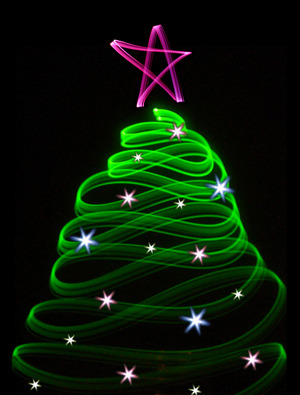Yule, not to be mistaken for Christmas, has ancient roots that pre-date any Christian holiday. Yule usually was celebrated around the Winter Solstice (December 21st) and lasted into January (around the third). The exact date of Yule or Yuletide differed between the ancient Indo-European tribes. These ancient cultures even had a Father Yule (Odin) who would ride his flying horse Sleipnir. The children would leave Sleipnir carrots, straw or sugar and something warm to drink for Father Yule. As reward for their kindness Father Yule would leave gifts or candy (or both) for them. He did this while everyone was sleeping. This one night visit by Father Yule happened during the Yuletide (December 21 through January 3rd), varying per Indo-European community (tribe) which spanned the Northern European countries. It was believed that Father Yule needed time to visit every kind children’s’ home, why he had December 21 through January 3rd window to visit). Why each tribe had Father Yule visit at different nights throughout the Yuletide. Yule was a joy-filled, happy, peaceful, optimistic time of the year where the ancient Indo-Europeans would look favorably toward the New Year. It was filled with merriment, anticipation, delight, and joy.
The main feast of Yule originally corresponded with the Winter Solstice (December 21st), but with the Christianization of Europe it was changed to December 23, 24, 25, or 26 depending upon the Northern European country celebrating. The English word “Yule” is believed to originate from Old English (Anglo-Saxon) and Old Norse. This word’s meaning is believed to mean “wheel” or “feast” or “feast of the wheel”. The exact meaning is unknown even by etymologists who continue to debate its actual meaning. Yule had many traditions including a Yule tree, Yule goat, Yule boar, and Yule singing.
The Yule log was originally a very thick wooden log that was burned in the hearth throughout the Yuletide in order to keep the home warm and cozy. The dessert known as a Yule Log debuted in the 18th century in France and became a traditional Christmas French confection. This idea, out of popularity, did spread throughout Europe and eventually was called the Yule Log and adopted as a Yule dessert.
The Yule tree was an evergreen that hung upside down and was decorated with handmade decorations. Some of these decorations would be symbolic, held the meaning of Yule, upon the boughs of the Yule tree. Gifts were placed under the tree for the main days of Yule (December 21, 22, 23, or 24th) when they would be opened either before or after the main Yule feast.
The Yule goat is the eldest Yule symbol and tradition in Scandinavia and Northern Europe. It usually was the goat who was slaughtered and eaten at the primary Yule feast. It was also a goat made out of straw as a Yule decoration in honor of the slaughtered goat. This straw goat was customarily used by carrying it door to door while singing Yule carols.
The Yule boar was usually set aside in honor of Freyr (Ingwi in England), Norse (Anglo-Saxon in England) god of agriculture. The Yule boar was a wild boar slaughtered, then eaten on December 26th (the Day of Freyr). Toasts to Freyr asking for a good agricultural new year were part of eating the boar and feasting.
Yule singing was accomplished by going door to door singing merry uplifting songs about Yule and the Yuletide (with or without the straw Yule goat). This was done during the entire Yuletide (December 21st through January 3rd) in towns or cities. The rural people did their Yule singing in orchards or fields. This tradition was primarily Anglo-Saxon who sang joyful songs about the oncoming New Year.
For The Norse people celebrating Yule was mostly feasting for many days, drinking lots of mead, giving toasts with boasts, and reciting poetry or sagas. Wild boar or cod was the usual main course of the feast. It was communal and done more in a potluck fashion where every Norse in the community (rural area, town, or city) would bring a dish or two. The host would supply the wild boar or cod that would feed the entire community. It was a time when the Norse would set aside their differences, eat, drink and be merry; have joy and peace within the community.
In Denmark, Yule (Jul) is celebrated December 24, 25, and 26th as three days of festivities. For them Yule’s eve day, December 24th, is the most important of the three days of Yule where they have a great feast and afterward the children pass out the gifts from underneath the Yule tree and then open these gifts. It is said that Father Yule drops off the kind children’s’ gifts or candy the night before (December 23rd). December 25th (Yule day) is filled with family socializing, visiting relatives, that sort of thing. December 26th (day after Yule) is when they eat the Yule feast leftovers and sing Yule songs. The most traditional main courses for Yule’s eve is duck, pork, and goose.
Sweden celebrates Yule similarly to the the Danes. Yule day differs, however, being December 24th and the main dish for the Yule feast is customarily pickled herring. For the Swedish, Yuletide covers the entire month of December filled with visiting friends, relatives, caroling, gift giving, and time of joy.
In Estonia, Yule is celebrated between December 21st through December 27th. Each Yule decorated home has a Yule candle burning all the time during the days of Yule and all windows had to be covered so the outside can not see the light. This is a time when families feast and spend time together playing games and figuring out riddles.
In Finland, it is the Yule goat (a white bearded man dressed in goat skins, red scarf, and walking stick) who rides a sleigh with reindeer, visits the homes by knocking on the front door, and upon entering asks if there are any kind and good children present. If there are, the Yule goat gives the children presents that he has made in his workshop in Lapland, then visits awhile with the family and eats leftovers. The Yule goat is married to Mother Yule.
In Iceland, the Yule tradition has the Yule lads act as Father Yule, bringing gifts to the children. Icelandic children leave their shoes on the window sills so the Yule lads can open the window and place their candy, apple or toy in them if they are good. Bad children get a potato in their shoe. December 23rd or 24th is usually when the Yule lads stop by for the children. It is said they come from the highest mountain in Iceland. The traditional Yule feast days are December 24th and 25th. The Yule feast traditional main course is lamb. December 26th (last day of Yule) is reserved for family gatherings which involve eating a lot of food with family members.
The Shetland Islands have the main Yule day as December 31st. On this day, they feast and welcome the New Year. It is on New Year’s day that they give and open presents. Father Yule drops off the kind children’s special gifts on New Years eve after the children have gone to bed.
In Germany, Belgium, and Netherlands, the children leaving carrots, straw or sugar for Father Yule’s horse Sleipnir and a hot drink for Father Yule is still practiced along with the Christmas festivities. Father Yule delivering kind children gifts or candy gives great joy to those in these countries. Yule is celebrated in Germany, Belgium and the Netherlands usually around December 25th. Ham and sausages are the usual main dishes.
Even though the Yule traditions vary where Yule is celebrated, it is a joyful time of gift giving, family gatherings, visiting of friends, feasting, singing merry songs, and enjoying a Yuletide of peace and joy with the anticipation of a great New Year.
Myths of the Norsemen from the Eddas and Sagas, by H.A. Guerber, Dover Publications, Inc., New York, 1992, pages 124 – 128
The Poetic Edda, translated by Henry Adams Bellows, on-line book website: http://www.sacred-texts.com/neu/poe/
Yule, Wikipedia website: http://en.wikipedia.org/wiki/Yule
Father Yule, Wikipedia website under Santa Claus: http://en.wikipedia.org/wiki/Santa_Claus
Yule log, Wikipedia website: http://en.wikipedia.org/wiki/Yule_log
Yule goat, Wikipedia website: http://en.wikipedia.org/wiki/Yule_goat
Yule lads, Wikipedia website: http://en.wikipedia.org/wiki/Yule_Lads



